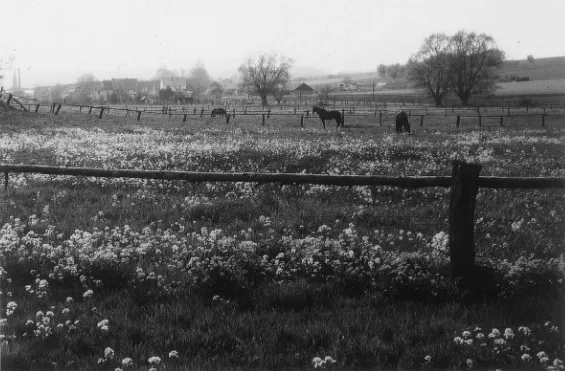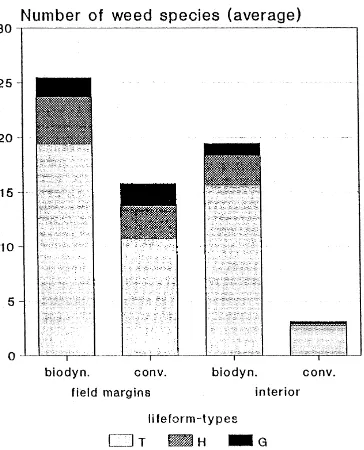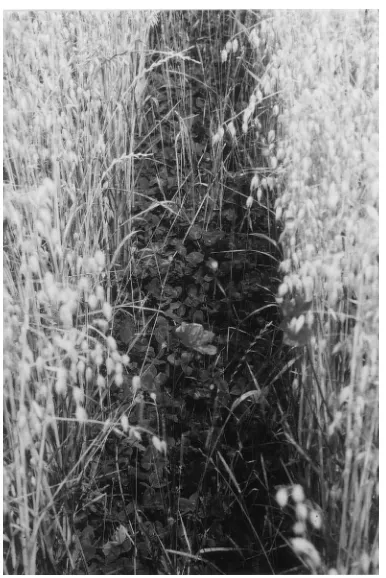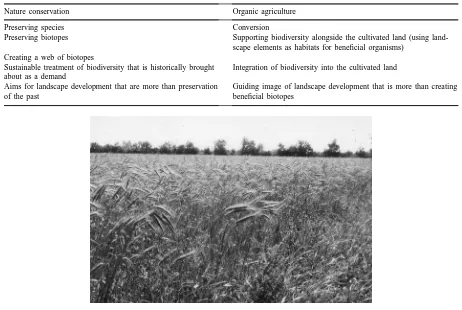Species diversity as a task for organic agriculture in Europe
Thomas van Elsen
∗Department of Ecological Agriculture, University of Kassel, Nordbahnhofstr. 1a, D-37213 Witzenhausen, Germany
Accepted 19 July 1999
Abstract
Different levels of biodiversity — species, biotopes and landscapes — can be differentiated and used for the assessment of the biotic environment of organic farms. Could the integration of species diversity into the cultivated land be a task for organic farming in the future? For hundreds of years agriculture supported the enrichment and the diversification of the vegetation in Central Europe. Nowadays many landscape elements are no more than relics of historical land use. Todays’ intensive agriculture is considered to be the main agent responsible for the decline of plant species. What are the effects of sustainable ways of agriculture on biodiversity, especially on the diversity of arable field plants? Many investigations show positive effects of organic agriculture on the diversity of arable fields and grassland, too. A higher number of species and also more endangered ‘red list’ species are to be found in organic fields. Different effects of agricultural practices in organic farming on the weed flora are discussed.
Today economic pressure leads to an improvement in mechanical weed control and undersowing. This shows that the aim of preserving, supporting and developing a diverse arable field flora cannot be reached automatically by converting to organic farming: an integration with the guiding image of organic agriculture is needed. Measures to support the richness of species of arable field plants in organic fields are shown.
Many organic farmers are aware of correlations between an impoverished landscape and the appearance of pests and diseases and try to enrich the landscape with biotopes. Despite all the benefits of organic farming for nature the danger of separation arises in organic farming too: the separation of the landscape into 5% ‘biotopes’ where nature is allowed to develop and into 95% ‘production area’ being used intensively. One step further would be the development from separation to integration of biodiversity into the method of organic farming as a whole — a way which corresponds with modern aims of the nature conservation movement. The ‘integrated table of landscape quality aspects’ developed during the work of the concerted action ‘The Landscape and Nature Production Capacity of Organic/Sustainable Agriculture’ could be useful for the assessment of organic farms under various aspects of biodiversity. It might help to change the farmers’ viewpoint and make them assess their particular landscape values and their landscape components with new eyes. ©2000 Elsevier Science B.V. All rights reserved.
Keywords: Biodiversity; Weeds; Arable field plants; Organic farming; Species diversity; Vegetation; Landscape; Nature conservation; Biotopes
∗Corresponding author. Tel.: +49-5542-981-655;
fax: +49-5542-981-568
E-mail address: [email protected] (T. van Elsen)
1. Introduction
Organic agriculture tries to produce healthy food under environmentally sound conditions. In recent years a lot of research has been carried out on organic agriculture’s effects on biodiversity (i.e., Youngberg et al., 1984; Isart and Llerena, 1996). Furthering
farming in the future.
2. Landscape and agriculture — a historical view
For hundreds of years agriculture has not only pro-duced food for human beings; it has had a high ‘land-scape and nature production capacity’ (van Mansvelt and Stobbelaar, 1995) as well. After the last Ice Age ended more than 10 000 years ago, the vegetation in Central Europe became dominated by woodlands. Due to the seasonal rhythm the different rocks and soils were colonized by plants; without disturbance the succession tends toward a vegetation dominated by woods.
The beginning of woodland clearance introduced a phase of anthropogenous enrichment and differentia-tion of vegetadifferentia-tion (Pott and Hüppe, 1991). In wood-lands, ecological variations of different areas are di-minished by the microclimate, whereas the different soil conditions are very important for the diversifica-tion of the plant communities that follow after clearing the trees. A wide spectrum of different ways of us-ing the land followed after clearus-ing; by replacus-ing most of the woods and through the introduction of agricul-ture the diversity of plant and animal species in the landscape increased (Hüppe, 1990). In a process tak-ing hundreds of years the natural landscape changed into a ‘cultural’ (rural) landscape that allowed more species to live. The landscape was divided into settle-ments with gardens, stone walls and livestock breed-ing and — around the villages — into arable land, or-chards, grassland and hedgerows, which connected the
pear not only due to the different types of soil: the combination of species differs in a typical way depend-ing on whether the field is ploughed in autumn or in springtime (van Elsen, 1994a). Also, in former times the use of manure led to an increase in diversity in the landscape (van Elsen, 1994b). Even forms of agricul-ture that caused environmental problems and could be considered as anything but sustainable (cf. Makowski and Buderath, 1983) contributed to the enrichment of biodiversity. One reason for this was that due to the lack of technical tools human beings did not have the ability to destroy aspects of nature (Falter, 1992). Dif-ferent regions vary with respect to their customs, tra-ditional costumes, dialects, structure of the villages and types of farmhouses (Ellenberg, 1990). Peoples’ and their different ways of farming also influenced the cultural landscapes that developed out of the natu-ral landscape. Until the industrialization of agriculture began, mans’ shaping of nature (resulting out of his essential needs, Konold, 1996) resulted in an increase of biodiversity in the Central European landscape.
Fig. 1. Traditional agriculture lead to an increase of biodiversity in the landscapes.
whereas shallow limestone soils become abandoned, supported by set-aside programs. In many cases such fields were the last reserves for annual field plants — without regular ploughing annual weeds disappear and perennial plants take over (van Elsen and Gün-ther, 1992). A similar development on the grassland takes place. Through the use of mineral fertilizer and early cutting the spectrum of plants has been reduced to a few species, while mowing or grazing of grass-land with low yields is not profitable anymore: shrubs and trees take over, and biotopes for a lot of plants and animals disappear. The effects of today’s agricul-ture are the opposite of agriculagricul-ture’s former tendency which allowed a development from the natural land-scape toward the mosaic of Central European cultural landscapes. Today agriculture is considered to be the main agent for the decline of plant species in Germany. An analysis of the Red List of extinct, missing and endagered wild plants by Korneck and Sukopp, 1988) shows that agriculture is responsible for the decline of 513 out of 711 species that were evaluated. Of all endagered plant species 10.8% are arable field plants, in addition, 15 ‘weed’ species have already become extinct (=25% of all extinct plant species).
3. Effects of organic farming on arable field plants
A small but growing number of farmers try to cul-tivate their land without using artificial fertilizer and
pesticides. They strive for a wider crop rotation and due to idealistic and/or economical reasons they have converted to organic farming. Weed control takes place by using mechanical tools, flame-weeders in vegetable-fields, undersowing in arable fields and by using field-fodder as a crop for one or two grow-ing seasons durgrow-ing the rotation. What are the effects of sustainable ways of agriculture on biodiversity, especially on the diversity of arable field plants?
3.1. The weed flora on organic fields
Fig. 2. Number of weed species in differently managed root crop fields (T = Therophytes, H = Hemicryptophytes, G = Geophytes) (Graphics-file).
small benefits to species diversity because of mechan-ical weeding and the use of herbicides for a long pe-riod before conversion (Albrecht and Mattheis, 1996). Comparisons by the author of neighbouring biody-namic and conventional root crop fields (van Elsen, 1989) show that the median number of wild plant species in the biodynamic field margins was 25 (aver-age 25.5), compared with 16 (aver(aver-age 15.8) in the con-ventionally managed fields (Fig. 2). In the centre of the fields, the median number of weeds in the biodynamic fields was 18 (average 19.5) compared with only two (average 3.2) in the conventional fields (Fig. 1). The range of the number of species at the margins of 17 fields is 9–46 (biodynamic), 2–25 (conventional); and in the centre of fields is 7–30 (biodynamic) and 0–11 (conventional).
An analysis of the spectrum of species shows that the field margins support a community of arable field plants described as typical for root crop fields in phy-tocoenological literature. Many of these species also appear in the conventional field margins, but less fre-quently and often as single specimens. In the middle of the biodynamic fields most of the species from the margins are also found, whereas almost all species typical of root crop fields are missing in the centre of
tre are the light factor, the different microclimate, soil compaction, different seed-bank, the ability of plants to invade from neighbouring plots and a lower intensity of farming compared to the field as a whole.
3.2. Effects of agricultural practices in organic farming on the weed flora
Table 1 summarizes the effects of various agricul-tural practices in organic farming on the weed veg-etation, based on six years of research in the Lower Rhine Plain and on unpublished data from Hessia and Thuringia.
Conversion to organic farming leads toward changes within the weed vegetation. After stopping the use of herbicides nitrophytes like Galium aparine might ‘explode’, normally a gradual decline of species being in need of a high nitrate level follows and legumes (esp. Vicia spp.) take over (and also might become problem weeds, Eisele, 1996). Plants that depend on a high amount of light are encouraged by a greater distance between the rows which is 18 cm on most organic farms instead of 13–14 cm conventionally.
Table 1
Effects of agricultural practices in organic farming on the weed vegetation
Agricultural measures Effects
During the period of conversion
cessation of chemical weeding Pronounced appearance of resistant ‘problem weeds’ before
cessation of mineral fertilizer application Gradual decline of weeds like Galium aparine which need a high nitrate level; increase of legumes (esp. Vicia spp.)
Mechanical weeding Decline of long-lived winter annuals and support of short-lived summer annuals; therefore danger of static and impoverished weed vegetation
Undersowing in winter grains Due to weather weeds may be shaded out
Growing perennial field-fodder Long-lived annuals cannot develop; increase of perennial species like Rumex crispus, R. obtusifolius; few weed problems after next ploughing
Turning of the stubble immediately after harvest Decline of late-flowering weed species that need stubble fields to develop (Kickxia spp., Stachys arvensis)
Use of own seeds Possibly spreading of seeds of other cultivated and wild plants Composting manure Spreading of nitrophytic plants (esp. Chenopodiaceae) on fields Frequent driving on fields Increase of plants appearing on compressed soils
Investigations on fields during a period of six years show that most annual weed species occur mainly on winter-crop fields. Examples are Apera spica-venti and Veronica hederifolia, which germinate in autumn and overwinter. Species like Thlaspi arvense, Fallopia
convolvulus and Chenopodium album occur primarily
on summercrop fields; the latter is a good example of the extent to which the growth form of weeds can dif-fer depending on difdif-ferent times of germination.
Often Trifolium, Lolium and Medicagospecies are used for undersowing with grain. Due to weather fac-tors it can happen that the stands produce too much shade for most of the arable field weeds to grow (Fig. 3). After harvesting the undersown legumes and grasses are used as field-fodder for one or two years; the fields get mown or grazed several times each year. During that period some additional wild species in-crease, i.e., Taraxacum officinale, Ranunculus repens and Plantago major. On the one hand, the cultivation of legumes is used for the enrichment of nitrogen, but they also provide indirect weed control because annual weed species in particular are reduced. The weed veg-etation under field fodder is different from the weed vegetation under grain and root crops. Many thero-phytes with a rhythm of development similar to winter grains (i.e., Centaurea cyanus, Papaver rhoeas, Vicia
spp.) are unable to flower and complete their life
cy-cle. If they do germinate, they remain vegetative. In addition, the frequency of short-lived annuals like
Stel-laria media and Veronica persica is strongly reduced,
but at least some plants are able to develop on small
Fig. 3. Undersowing can lead to a decline of weed species.
collected on the farm might lead to a spreading of some weed species. Also, composting the manure can cause a spreading of some species over the farm. The high frequency of species like Poa annua and Plantago
major might be caused by frequent driving on the fields
with heavy machinery leading to compacted soils.
3.3. Measures to encourage the diversity of arable field plants on organic farms
Many investigations show the positive effects of organic farming on the diversity of arable field plants, but today economic pressure leads to an improvement of mechanical weed control and undersowing. These measures threaten sensitive winter annuals with a similar life cycle to the grains in particular, while short-lived summer annuals may grow even better after mechanical weeding due to weather factors. The floristic differences between fields with grain and root crops become less and less distinct.
The aim of preserving, encouraging and developing a diverse arable field vegetation cannot be reached au-tomatically by converting to organic farming. An inte-gration with the aims of organic agriculture is needed. One step in this direction is to consider arable field plants as hosts and food for beneficial insects (Rup-pert, 1993; Lys et al., 1994; Raskin, 1994) that they have a positive effect of weeds on the soil. Preserving weed species with their flowers for utilitarian purposes would be a first step toward a more conscious approach to arable field plants which goes beyond merely sup-pressing and destroying unwanted weeds. Some pos-sible measures to encourage the species diversity of
organically farmed land — a task ignored by organic agriculture?
Many organic farmers are aware of correlations be-tween an impoverished landscape and the appearance of pests and diseases. Many scientific studies show the importance of habitats like hedgerows, ponds, weed strips and meadows with flowers for agents of biolog-ical control. So more and more organic farmers try to enrich their landscape by planting hedgerows or build-ing ponds (Lampkin, 1990; Altieri et al., 1996; Stopes and Woodward, 1996). Standards and directives (e.g. to have at least 5% natural habitats for wildlife on each farm) can be a vehicle in this direction.
The enrichment of the landscape with biotopes is clearly an important measure, but at the same time the danger of separation (Fig. 4) arises. In organic farm-ing the division of the landscape into 5% ‘biotopes’ where nature is allowed to develop and 95% inten-sive ‘production area’ does not leave much room for wild plants and insects to live in the optimized fields and grassland stands. Despite all the benefits of or-ganic farming for nature and biodiversity, symptoms of such a development are common. The situation of plant and animal communities in organic grassland is similar (cf. Mahn, 1993; Rösler and Weins, 1997) to the example of arable field plants described above.
Fig. 4. Separation of the fields into ‘biotopes’ and into ‘production area’.
Table 3
From separation to integration — the development of ‘nature and landscape production’ in the nature conservation movement and in organic farming
Nature conservation Organic agriculture
Preserving species Conversion
Preserving biotopes Supporting biodiversity alongside the cultivated land (using land-scape elements as habitats for beneficial organisms)
Creating a web of biotopes
Sustainable treatment of biodiversity that is historically brought Integration of biodiversity into the cultivated land about as a demand
Aims for landscape development that are more than preservation Guiding image of landscape development that is more than creating
of the past beneficial biotopes
during the work of the concerted action named above, van Mansvelt, 1997) supporting sustainable forms of agriculture. Using the criteria for the assessment of organic farms under various aspects of biodiversity might help to change the farmers’ viewpoint and to make them view their particular landscape values and their landscape components with new eyes. If such an integration is successful and landscape development aims which go further than the creation of beneficial biotopes are developed and implemented, the vision of a partnership between a developing nature conser-vation movement and a developing organic agriculture might become reality for the future.
References
Albrecht, H., Mattheis, A., 1996. Die Entwicklung der Ackerwildkrautflora nach Umstellung von konventionellem auf integrierten bzw. ökologischen Landbau.. Z. PflKrankh. PflSchutz Sonderh. 15, 211–224.
Altieri, M.A., Nicholls, C.I., Wolfe, M.S., 1996: Biodiversity — a central concept in organic agriculture: Restraining pests and diseases. In: Østergaard, T.V. (Ed.), Fundamentals of Organic Agriculture. 11th IFOAM International Scientific Conference 11–15 August, 1996, Kopenhagen, Proceedings vol. 1: 91–112. Callauch, R., 1981. Ackerunkraut-Gesellschaften auf biologisch und konventionell bewirtschafteten Äckern in der weiteren Umgebung von Göttingen. Tuexenia 1, 25–37.
Eisele, J., 1996. Vicia hirsuta (L.) S.F.Gray ( Problemunkraut des Organischen Landbaus.. Z. PflKrankh. PflSchutz Sonderh. 15, 225–231.
Ellenberg, H., 1990. Bauernhaus und Landschaft in ökologischer und historischer Sicht. Stuttgart, 585 pp.
van Elsen, T., 1989. Ackerwildkraut-Bestände biologisch-dynamisch und konventionell bewirtschafteter Hackfruchtäcker in der Niederrheinischen Bucht. Lebendige Erde 4, 277–282.
— Veränderungen im Vergleich zu den Jahren 1959–1961. Diplomarbeit Univ. Bonn, 131 S.
Hald, A.B., Reddersen, J., 1990. Fugleføde i kornmarker — insekter og vilde planter. Miljøstyrelsens Miljøprojekt nr. 125, 112 pp.
Hampl, U., Herrmann, G., 1987. Vergleich des Ackerunkrautbe-satzes und dessen Kontrolle auf ökologisch und auf konventionell wirtschaftenden Betrieben. In: Hoffmann, M., Geier, B. (Eds.), Beikrautregulierung statt Unkrautbekämpfung, Karlsruhe, pp. 123–135.
Heinken, T., 1990. Die Ackerwildkraut-Vegetation auf biologisch und konventionell bewirtschafteten Ackerflächen bei Gut Adolphshof (Ldkrs. Hannover). Beitr. Naturk. Niedersachsens, pp. 38–45.
Hofmeister, H., 1992. Ackerwildkrautschutz auf der Wernershöhe, Landkreis Hildesheim (Nordwest-Deutschland). Tuexenia 12, 285–298.
Hüppe, J., 1990. Die Genese moderner Agrarlandschaften in vegetationskundlicher Sicht. Verh. Ges. Ökol. 19/2, 424–432. Isart, J., Llerena, J.J. (Eds.), 1996. Biodiversity and Land Use:
The role of Organic Farming. Proceedings of the First ENOF Workshop. — Barcelona, 155 pp.
Konold, W. (Ed.), 1996. Naturlandschaft — Kulturlandschaft. Die Veränderung der Landschaften nach der Nutzbarmachung durch den Menschen. Landsberg, 322 pp.
Korneck, D., Sukopp, H., 1988. Rote Liste der in der Bundesrepublik Deutschland ausgestorbenen, verschollenen und gefährdeten Farn- und Blütenpflanzen und ihre Auswertung für den Arten- und Biotopschutz. Schrr. Vegetationskunde 19. Lampkin, N., 1990. Farming systems and ecological diversity. —
In: Organic Farming (701 pp.), 574–579.
Lys, J.-A., Zimmermann, M., Nentwig, W., 1994. Increase in activity density and species number of carabid beetles in cereals as a result of strip-management. Entomol. Exp. Appl. 73, 1–9. Mahn, D., 1993. Untersuchungen zur Vegetation von biologisch und konventionell bewirtschaftetem Grünland. Verh. Ges. Ökol. 22, 127–134.
van Mansvelt, J.D., 1997. An interdisciplinary approach to integrate a range of agro-landscape values as proposed by representatives of various disciplines. Agriculture, Ecosystems and Environment. Amsterdam, Lausanne, New York, Oxford, Shannon, Tokyo 63 (2/3), 233–250.
van Mansvelt, J.D., Stobbelaar, D.J. (Eds.), 1995. Proceedings of the second plenary meeting of the EU-concerted action: The landscape and nature production capacity of organic/sustainable types of agriculture. Wageningen, 247 pp.
Meisel, K., 1978. Auswirkung alternativer Landbewirtschaftung auf die Vegetation. Bundesforschungsanstalt für Naturschutz und Landschaftsökologie (Edit.). Jahresbericht 10–12 Meisel, K., 1979. Auswirkung alternativer Landbewirtschaftung
auf die Vegetation. Bundesforschungsanstalt für Naturschutz und Landschaftsökologie (Edit.). Jahresbericht 1979, 12–13. Plakolm, G., 1989. Unkrauterhebungen in biologisch und
konventionell bewirtschafteten Getreideäckern Oberösterreichs. Diss. Univ. f. Bodenkultur, Wien, 269 pp.
Pott, R., Hüppe, J., 1991. Die Hudelandschaften Nordwestdeutschlands. Abh. Westf. Mus. Naturk. 53 (1/2), 313. Raskin, R., 1994. Die Wirkung pflanzenschutzmittelfreier Ack-errandstreifen auf die Entomofauna von Wintergetreidefeldern und angrenzenden Saumbiotopen. Dissertation Univ. Aachen, 142 pp.
Ries, C., 1988. Die Ackerbegleitflora des biologisch-dynamischen und konventionellen Pflanzenbaus in Hüpperdange (Luxemburg). Diplomarbeit Univ. für Bodenkultur, Wien, 129 pp.
Rösler, S., Schmidt, M., 1995. NABU-Grünbuch zum 2. Europäischen Naturschutzjahr 1995. Kritische Bilanz, Ausblick und Forderungen für Deutschland. Naturschutzbund Deutschland, Bonn, 67 pp.
Rösler, S., Weins, C., 1997. Situation der Vogelwelt in der Agrarlandschaft und der Einfluß des ökologischen Landbaus auf ihre Bestände. In: Weiger, H., Willer, H. (Eds.), Naturschutz durch ökologischen Landbau, Ökologische Konzepte 95, pp. 121–152.
Ruppert, V., 1993. Einfluß blütenreicher Feldrandstrukturen auf die Dichte blütenbesuchender Nutzinsekten insbesondere der Syrphinae (Diptera: Syrphidae). Agrarökologie 8, Bern, 149 pp. Stopes, C., Woodward, L., 1996. Hedgerow management and birds on organic farms. In: Kristensen, N.H., Høgh-Jensen, H. (Eds.), New Research in Organic Agriculture. 11th IFOAM International Scientific Conference 11–15 August, 1996, Kopenhagen, Proceedings vol. 2, 192–196.
Wolff-Straub, R., 1989. Vergleich der Ackerwildkraut-Vegetation alternativ und konventionell bewirtschafteter Äcker. Schrr. LÖLF 11: Alternativer und konventioneller Landbau, Recklinghausen, pp. 70–111.




